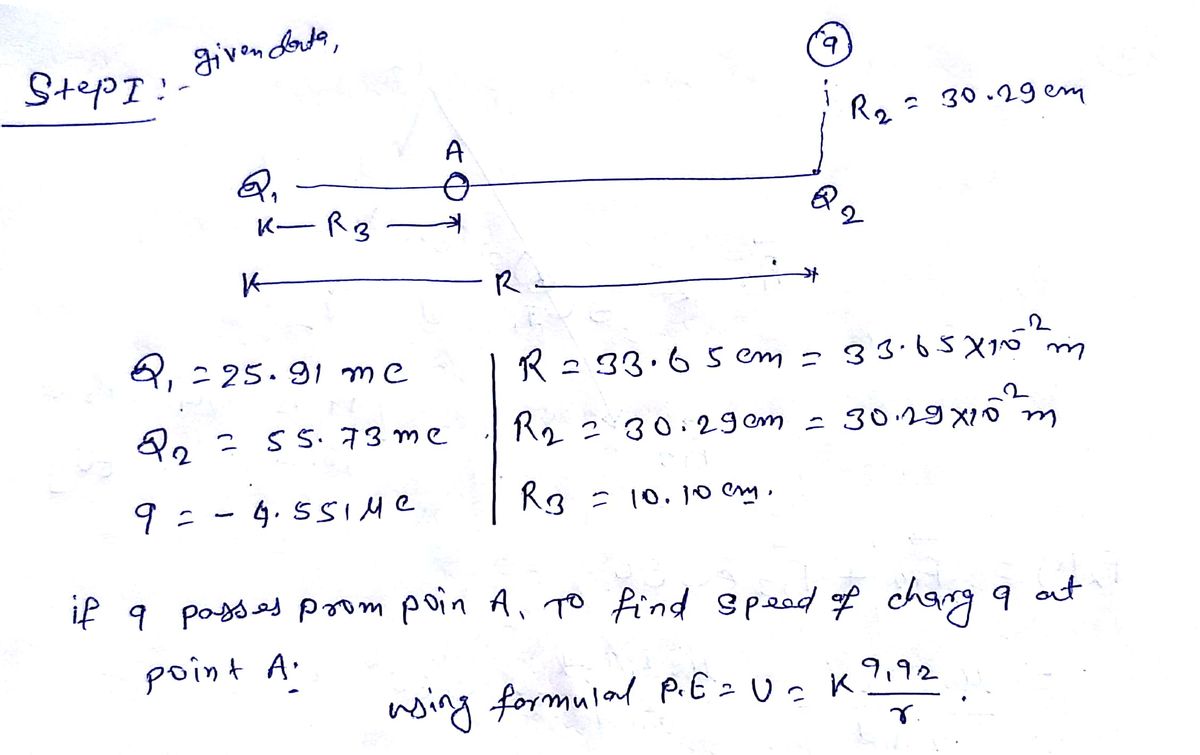Charge Q1 = 25.91 mC is placed R = 33.65 cm to the left of charge Q2 = 55.73 mC, as shown in the figure. Both charges are held stationary. Point A is located R3 = 10.10 cm to the R. right of Q1. A particle with a charge of q = -4.551 µC and a mass of A 19.81 g is placed at rest at a distance R2 = 30.29 cm above Q2. If the particle were to be released from rest, calculating -R its exact path would be a challenging problem. However, it is possible to make some definite predictions about the future motion of the particle If the path of the particle were to pass through point A, what would be its speed va at that point? VA = m/s
Charge Q1 = 25.91 mC is placed R = 33.65 cm to the left of charge Q2 = 55.73 mC, as shown in the figure. Both charges are held stationary. Point A is located R3 = 10.10 cm to the R. right of Q1. A particle with a charge of q = -4.551 µC and a mass of A 19.81 g is placed at rest at a distance R2 = 30.29 cm above Q2. If the particle were to be released from rest, calculating -R its exact path would be a challenging problem. However, it is possible to make some definite predictions about the future motion of the particle If the path of the particle were to pass through point A, what would be its speed va at that point? VA = m/s
College Physics
11th Edition
ISBN:9781305952300
Author:Raymond A. Serway, Chris Vuille
Publisher:Raymond A. Serway, Chris Vuille
Chapter1: Units, Trigonometry. And Vectors
Section: Chapter Questions
Problem 1CQ: Estimate the order of magnitude of the length, in meters, of each of the following; (a) a mouse, (b)...
Related questions
Question

Transcribed Image Text:Charge Q1 = 25.91 mC is placed R = 33.65 cm to the left of
charge Q2 = 55.73 mC, as shown in the figure. Both charges
are held stationary. Point A is located R3 = 10.10 cm to the
right of Q1.
A particle with a charge of q = -4.551 µC and a mass of
19.81 g is placed at rest at a distance R2 = 30.29 cm above
Q2. If the particle were to be released from rest, calculating
-R,-
R
its exact path would be a challenging problem. However, it is
possible to make some definite predictions about the future
motion of the particle
If the path of the particle were to pass through point A, what
would be its speed va at that point?
VA =
m/s
Expert Solution
Step 1

Trending now
This is a popular solution!
Step by step
Solved in 3 steps with 3 images

Knowledge Booster
Learn more about
Need a deep-dive on the concept behind this application? Look no further. Learn more about this topic, physics and related others by exploring similar questions and additional content below.Recommended textbooks for you

College Physics
Physics
ISBN:
9781305952300
Author:
Raymond A. Serway, Chris Vuille
Publisher:
Cengage Learning

University Physics (14th Edition)
Physics
ISBN:
9780133969290
Author:
Hugh D. Young, Roger A. Freedman
Publisher:
PEARSON

Introduction To Quantum Mechanics
Physics
ISBN:
9781107189638
Author:
Griffiths, David J., Schroeter, Darrell F.
Publisher:
Cambridge University Press

College Physics
Physics
ISBN:
9781305952300
Author:
Raymond A. Serway, Chris Vuille
Publisher:
Cengage Learning

University Physics (14th Edition)
Physics
ISBN:
9780133969290
Author:
Hugh D. Young, Roger A. Freedman
Publisher:
PEARSON

Introduction To Quantum Mechanics
Physics
ISBN:
9781107189638
Author:
Griffiths, David J., Schroeter, Darrell F.
Publisher:
Cambridge University Press

Physics for Scientists and Engineers
Physics
ISBN:
9781337553278
Author:
Raymond A. Serway, John W. Jewett
Publisher:
Cengage Learning

Lecture- Tutorials for Introductory Astronomy
Physics
ISBN:
9780321820464
Author:
Edward E. Prather, Tim P. Slater, Jeff P. Adams, Gina Brissenden
Publisher:
Addison-Wesley

College Physics: A Strategic Approach (4th Editio…
Physics
ISBN:
9780134609034
Author:
Randall D. Knight (Professor Emeritus), Brian Jones, Stuart Field
Publisher:
PEARSON